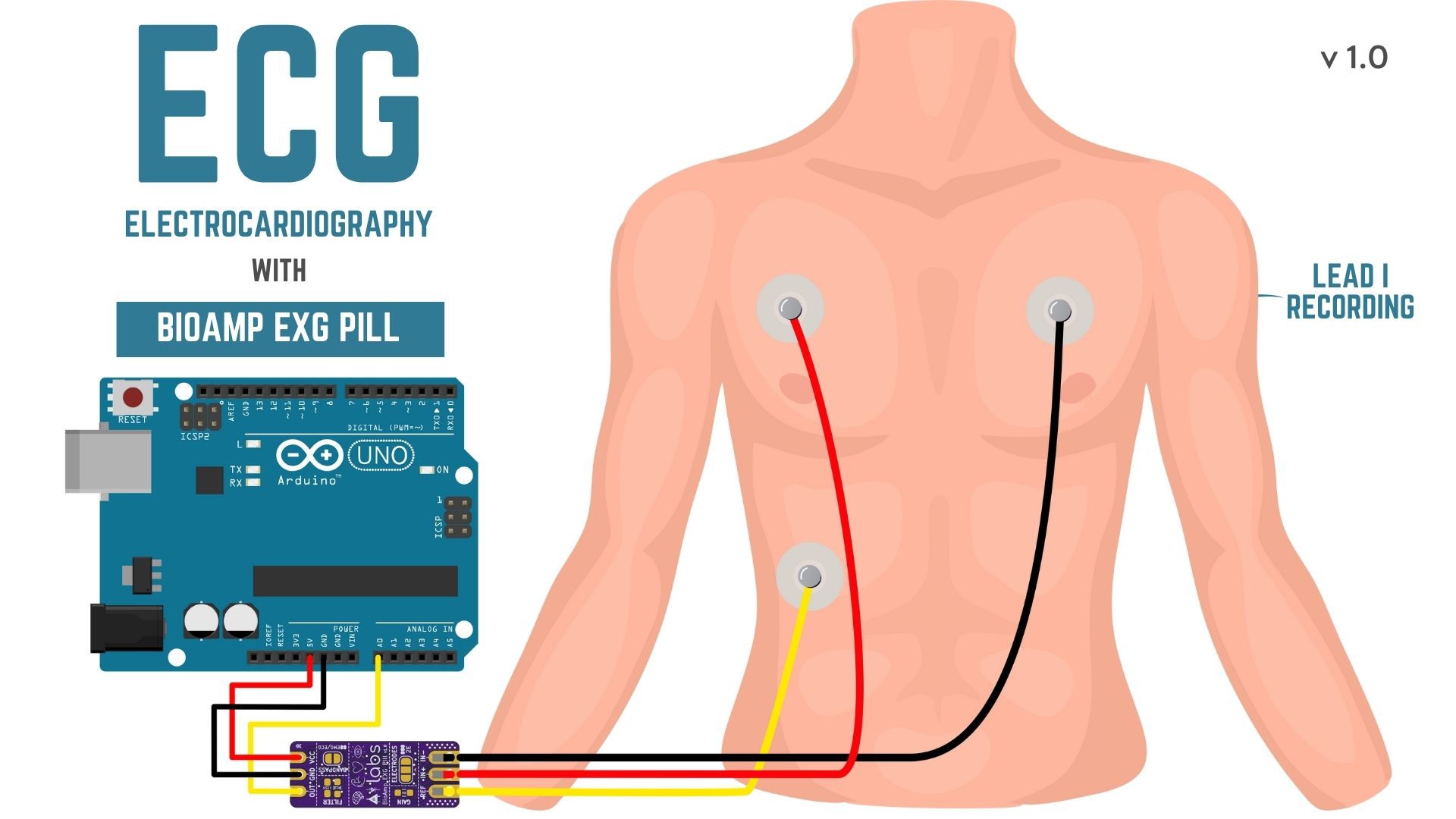BioAmp EXG Pill is a small, powerful analog-front-end (AFE) biopotential signal-acquisition board that can be paired with any microcontroller unit (MCU) or single-board computer (SBC) with an analog-to-digital converter (ADC) such as Arduino UNO & Nano, Espressif ESP32, Adafruit QtPy, STM32 Blue Pill, BeagleBone Black, and Raspberry Pi Pico, to name just a few. It also works with any dedicated ADC, like the Texas Instruments ADS1115 and ADS131M0x, among others.

BioAmp EXG Pill is capable of recording publication-quality biopotential signals like ECG, EMG, EOG, and EEG, without the inclusion of any dedicated hardware or software filters. Its small size allows easy integration into mobile and space-constrained projects, and its powerful noise rejection makes it usable even when the device is close to the AC mains supply. Any 1.5 mm diameter wire can be used as a strain-relieving electrode cable, making it very cost-effective in comparison to the other available options.
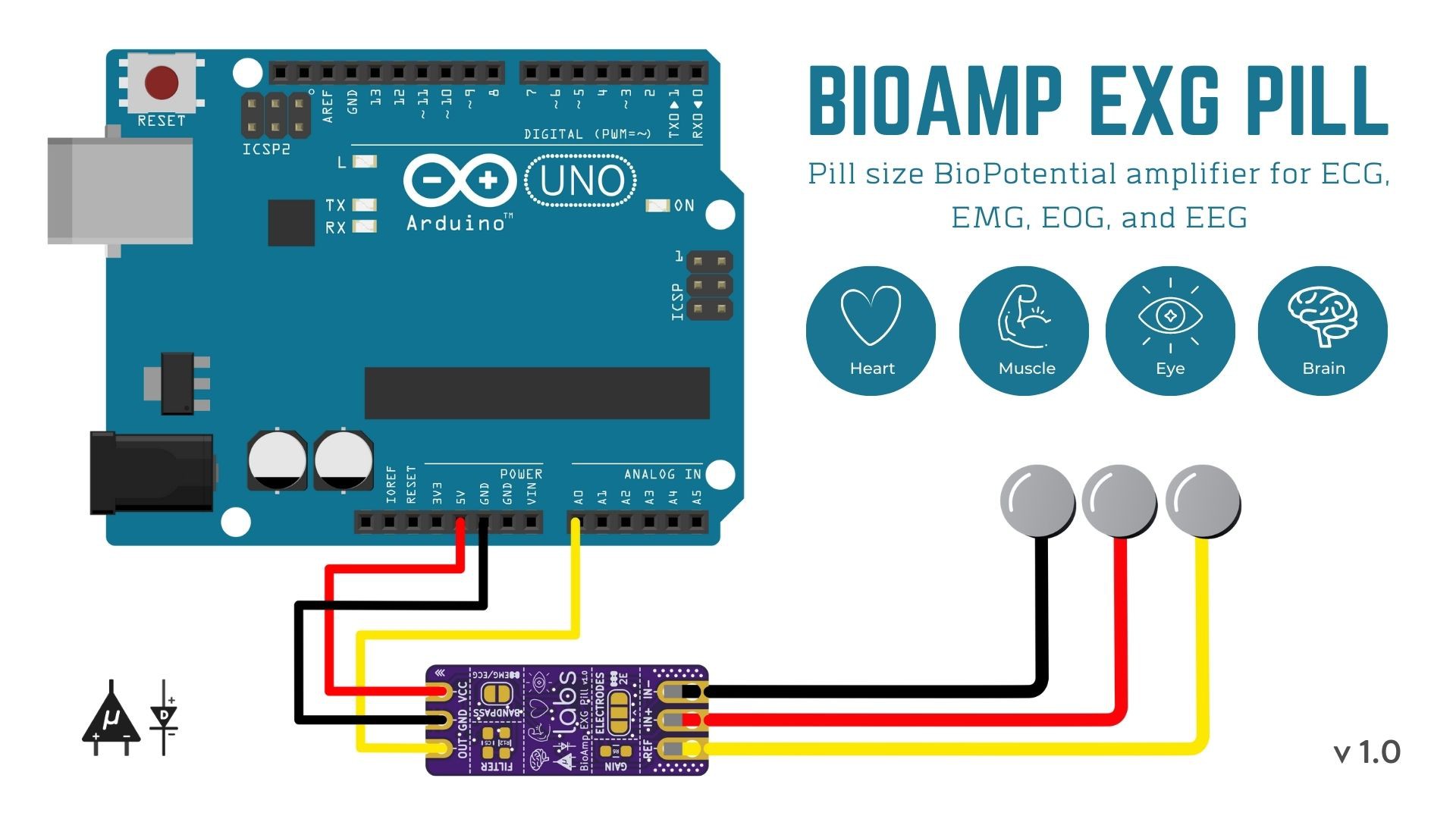
It is by default compatible with 5V but you can make it compatible with 3.3V devices as well using a voltage divider as shown in the diagram below:
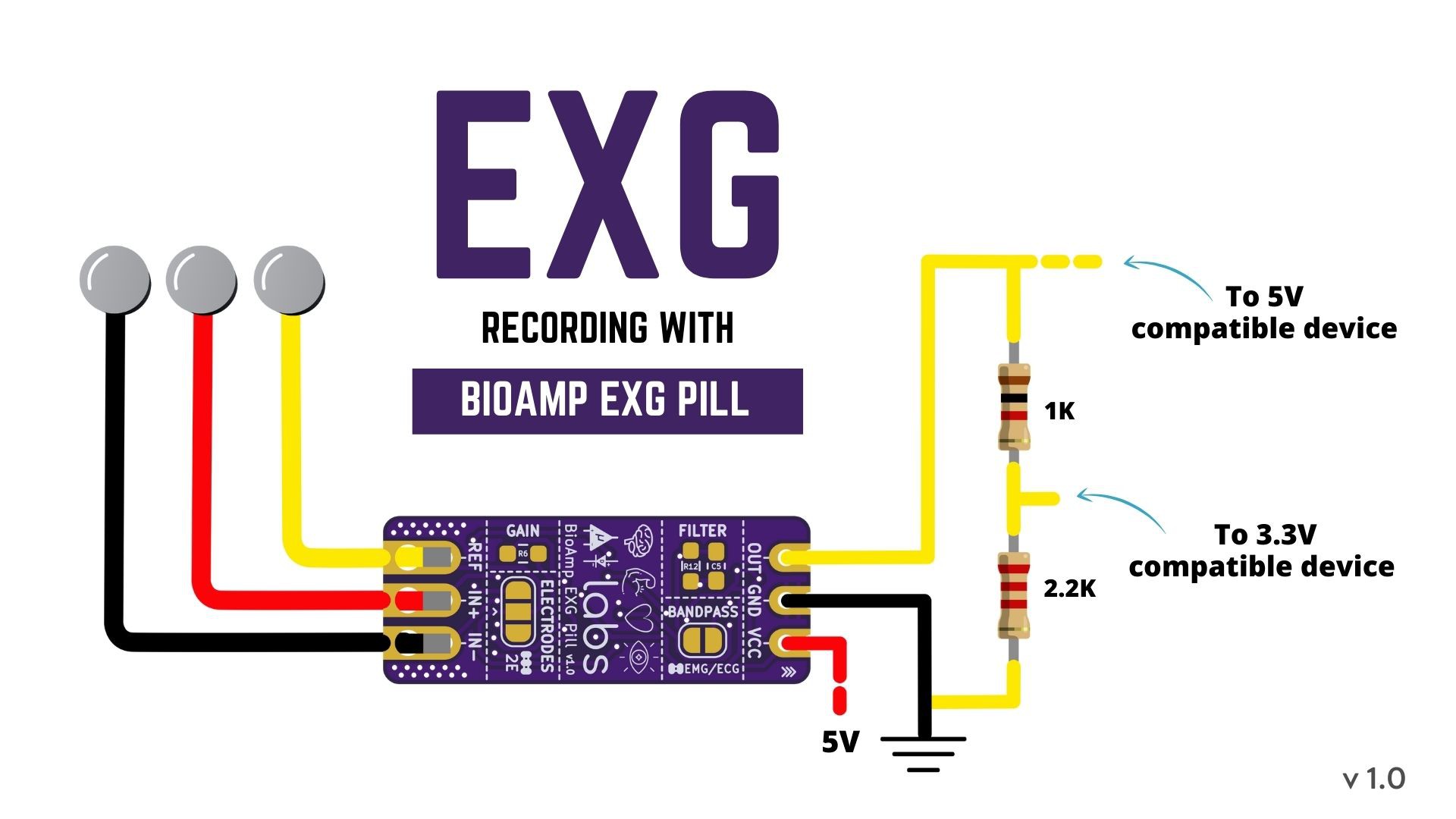
Features & Specifications
| Input Voltage | 4.5 - 40V |
| Input Impedance | 10^12 Ω |
| Compatible Hardware | Any ADC input |
| Biopotentials | ECG EMG, EOG, or EEG (configurable bandpass) | By default configured for EEG and EOG |
| No. of channels | 1 |
| Electrodes | 2 or 3 (configurable) | By default configured for 3 electrodes |
| Dimensions | 25.4 x 10.0mm |
| Open Source | Hardware + Software |
A lot has improved from v1.0b to v1.0 which is probably the final version of BioAmp EXG Pill. The feedback received from customers and the research and development we have done in the last several months have been fruitful to make improvements in the final version (v1.0) in terms of interference rejection and signal-to-noise ratio.
The YouTube video below shows the ECG, EMG, EOG, and EEG recording using v1.0b of the device.
Board Pinout Diagrams:
Front
BioAmp EXP Pill’s elegant design allows it to be used in 3 ways:
- Pin-header holes allow you to solder (berg strip) pin headers for easy use with a breadboard
- Castellated holes allow you to solder BioAmp EXG Pill directly onto a custom PCB that requires biopotential-amplification capabilities
- Electrode holes allow you to use any 1.5 mm diameter wire as an electrode cable with minimal strain

Back
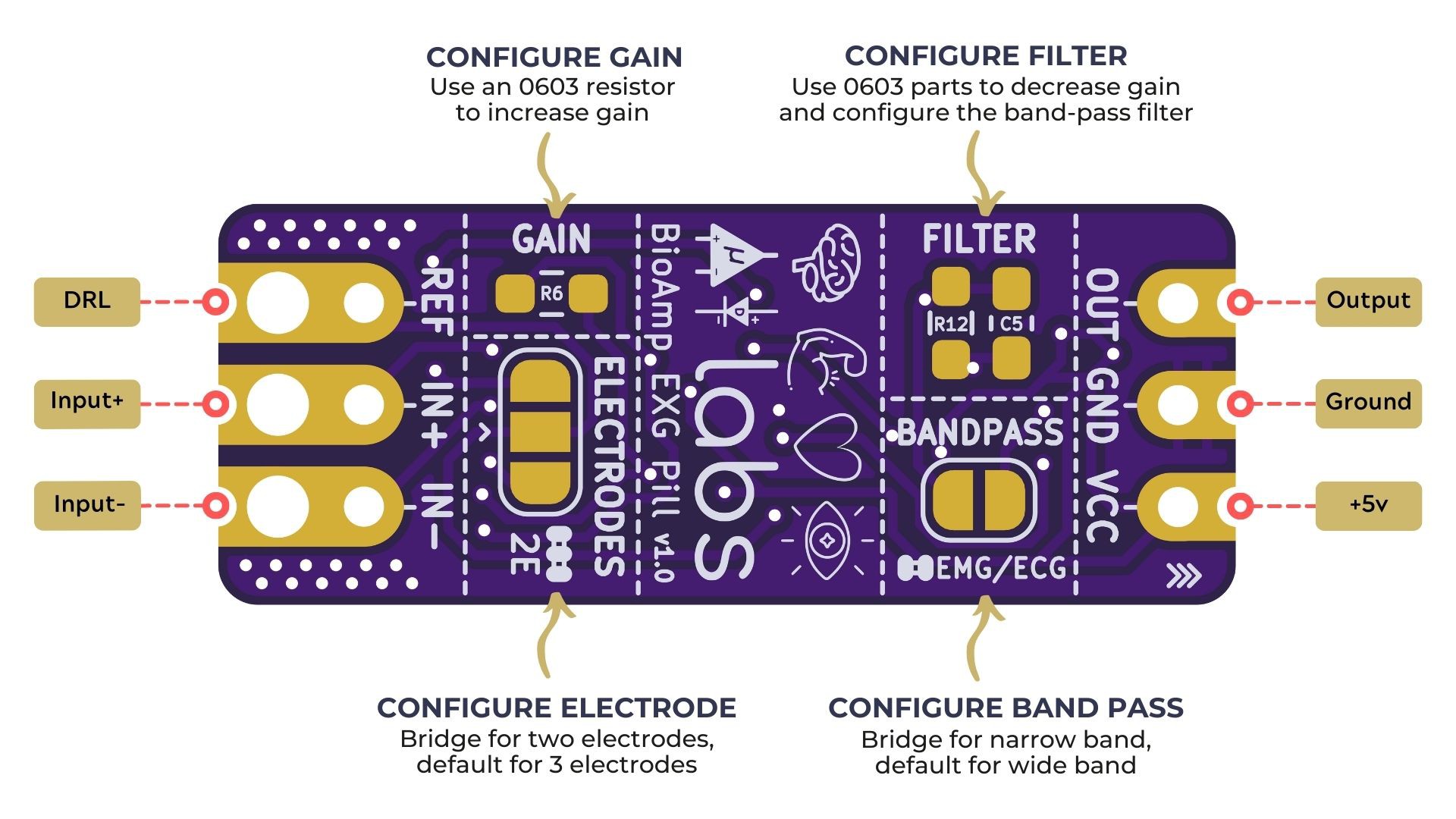
BioAmp EXG Pill is fully configurable as you can:
1. Increase the gain of the instrumentation amplifier by using a 0603 resistor at R6. Decrease gain and configure the bandpass filter by using 0603 parts at R12 and C5. Band limiting is very useful for EOG and EEG recording. Also, the signal sometimes clips while recording ECG with electrodes very close to the heart. Creating a solder jumper for a band-pass filter helps with that. By default, BioAmp EXG Pill is configured to record EEG and EOG but you can bridge the pads (below bandpass) with solder to make it configurable for EMG and ECG.
2. The normal method of operation for best-quality signal amplification is to use 3 electrodes by default but you can bridge the pads (below electrodes) to make it configurable for 2 electrodes. The 2-electrode mode is specifically included for projects like heart (ECG) patches for HRV. It's only supposed to be used with a battery-operated setup and is quite prone to high interference noise due to a lack of proper reference on the body (This option is not recommended for most operations)
Biopotential signals that can be measured using BioAmp EXG Pill:
1. Electromyography (EMG)
Electromyography (EMG) is a technique for evaluating and recording the electrical activity produced by skeletal muscles. EMG is also used as a diagnostic procedure to assess the health of muscles and the nerve cells that control them (motor neurons). EMG results can reveal nerve dysfunction, muscle dysfunction, or problems with nerve-to-muscle signal transmission.
The images below show an EMG wave recorded with BioAmp EXG Pill.
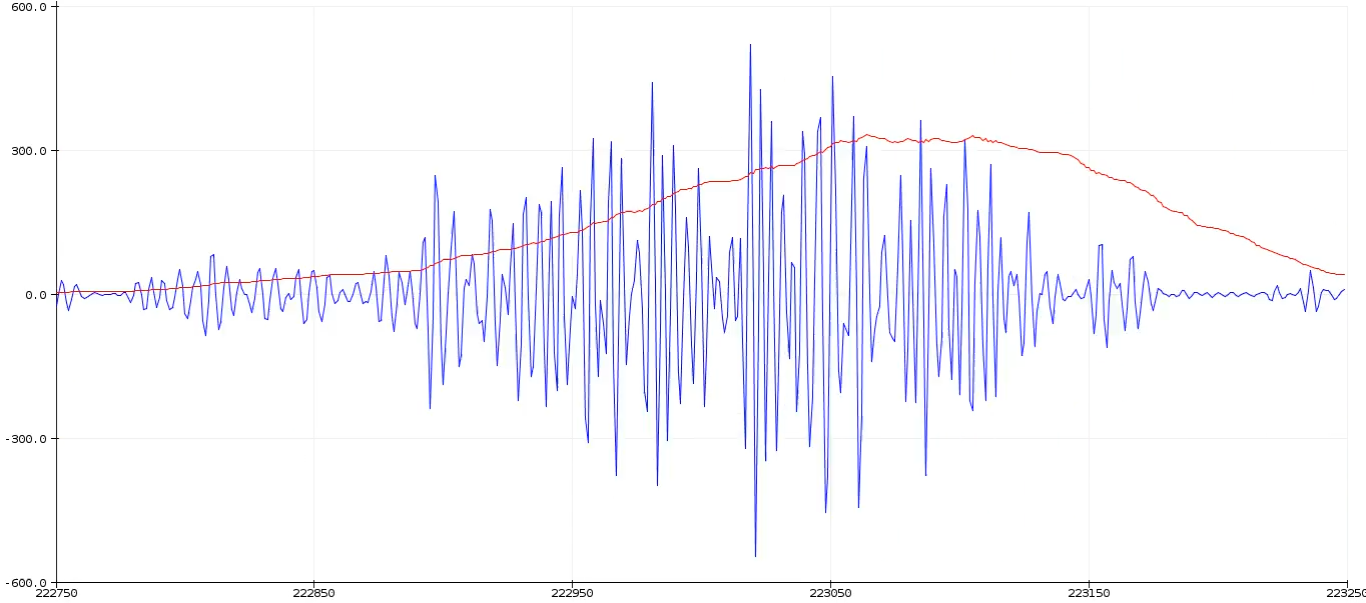
To record the EMG signals, the electrode placements and connections with Arduino Uno (or any other ADC of your choice) should be as per the picture given below.
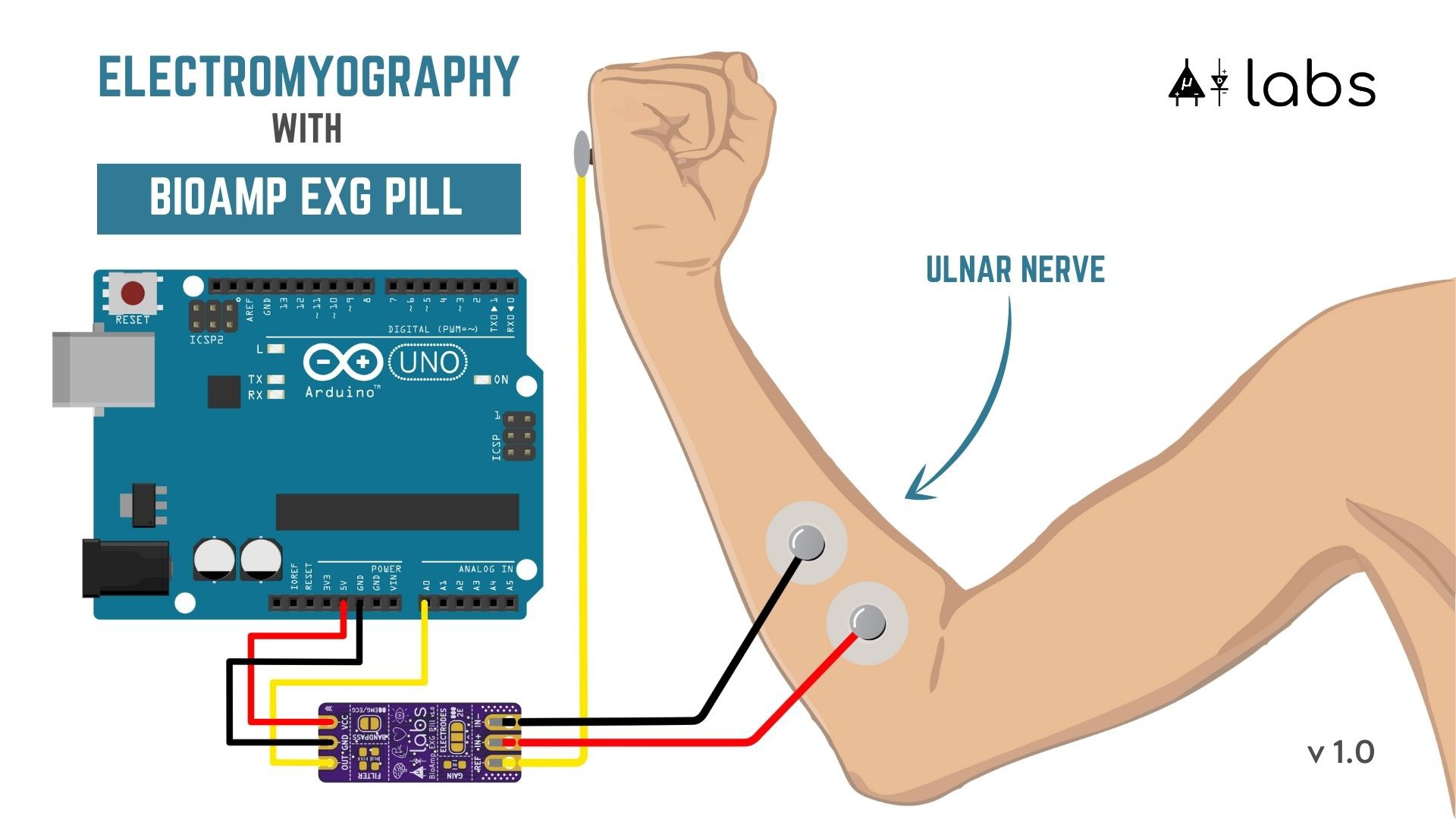
In this case, we have targeted the ulnar nerve on the forearm but you can target any other muscle as well, just make sure to place the reference electrode far from positive and negative electrodes, preferably on a bony part to have less interference from other muscles.
2. Electrocardiography (ECG)
Electrocardiography (ECG) is the process of producing an electrocardiogram (ECG or EKG). It is a graph of voltage vs time of the electrical activity generated in the heart which can be detected using electrodes placed on the skin. These electrodes detect the small electrical changes that are a consequence of cardiac muscle depolarization followed by repolarization during each cardiac cycle (heartbeat).
The images below show electrode placements for lead 1 ECG recording and hand EKG/ECG recording respectively.
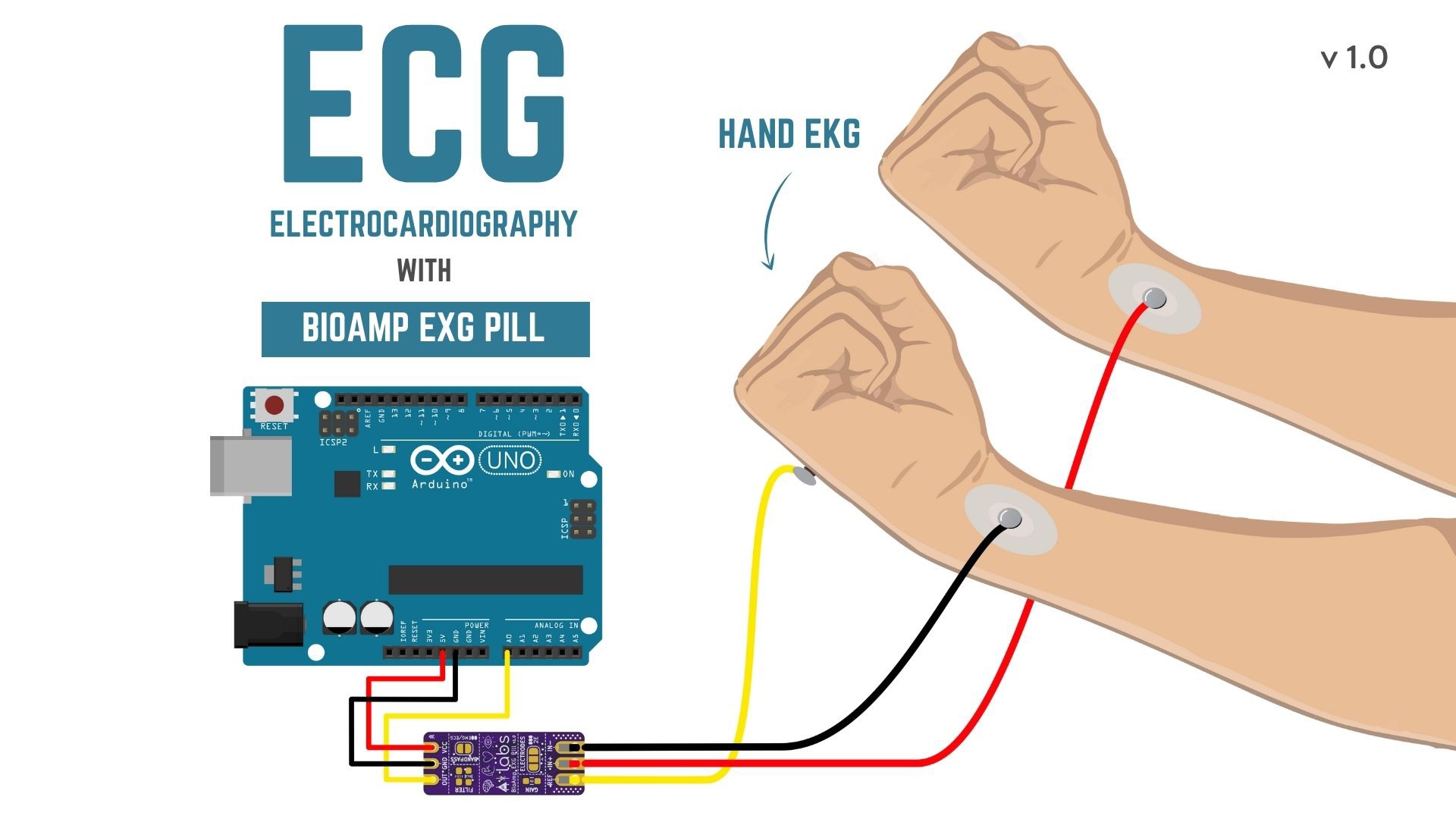
The ECG wave recorded with BioAmp EXG Pill can be found below:
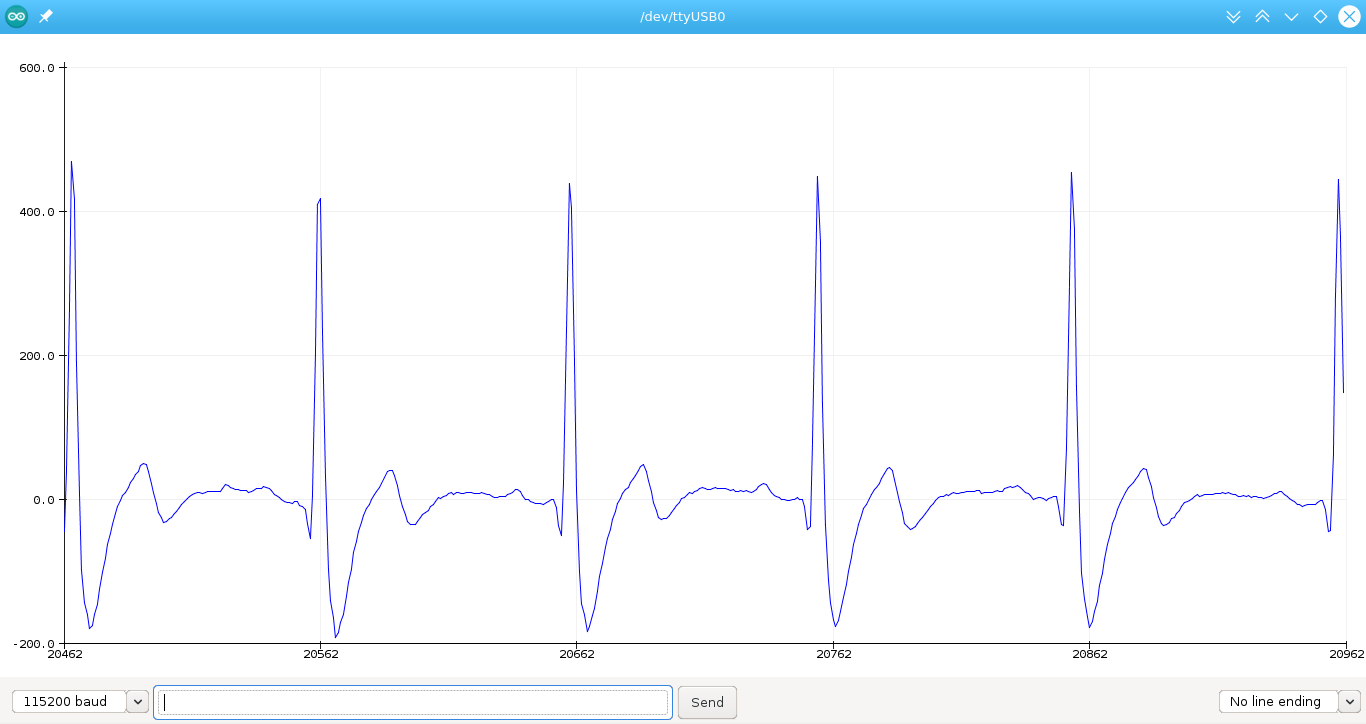
3. Electrooculography (EOG)
Electrooculography (EOG) is a technique for measuring the corneo-retinal standing potential that exists between the front and the back of the human eye. The resulting signal is called EOG.
Common electrode placement for vertical & horizontal EOG recording is shown in the image below.

To measure eye movement, pairs of electrodes are typically placed either above and below the eye (for vertical movement recording) or to the left and right of the eye (for horizontal movement recording). If the eye moves from the center position toward one of the two electrodes, this electrode "sees" the positive side of the retina, and the opposite electrode "sees" the negative side of the retina. Consequently, a potential difference occurs between the electrodes. Assuming the resting potential is constant, the recorded potential is a measure of the eye’s position.
The images below show electrode placement for horizontal EOG recording and vertical EOG recording respectively.


The EOG signal (horizontal movement) recorded with BioAmp EXG Pill can be found below:

4. Electroencephalography (EEG)
Electroencephalography (EEG) is an electrophysiological monitoring method to record electrical activity on the scalp. During the procedure, electrodes consisting of small metal discs with thin wires are pasted onto your scalp. The electrodes detect tiny electrical charges that result from the activity of your brain cells which are then amplified to appear on the computer screen. It is typically non-invasive, with the electrodes placed along the scalp.
The images below show the electrode placements to record EEG from the Pre-Frontal Cortex part of the brain.

The EEG signal (from Pre-Frontal Cortex) recorded using BioAmp EXG Pill can be found below:
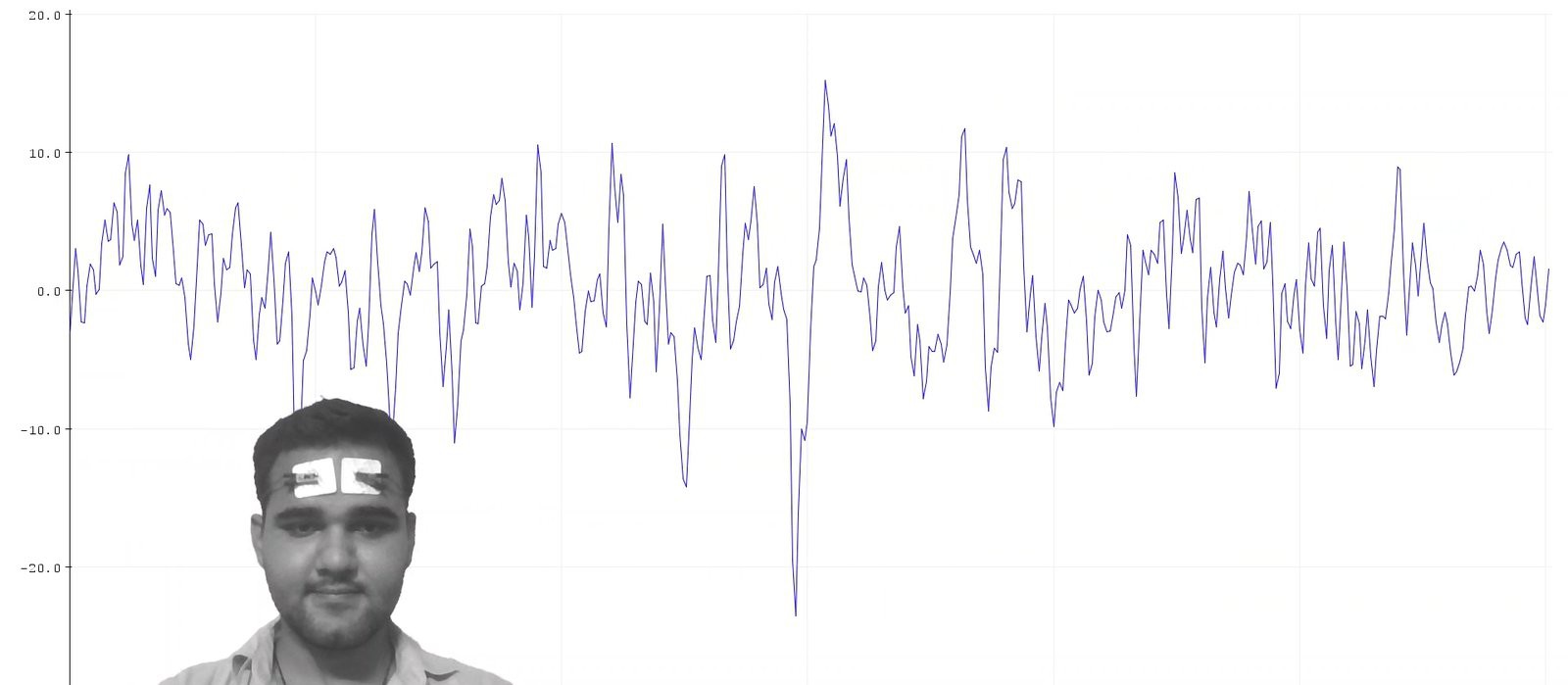
We also tried recording EEG signals from the Visual Cortex part of the brain (as shown in the video given below) and the results were really good as we were getting clean 10Hz signals whenever John was closing his eyes.
Recording and Visualizing biopotential signals on various softwares using BioAmp EXG Pill
1. Using Backyard Brains' Spike Recorder
2. Using Brainbay
Your One-Stop Shop for Biopotential Amplification
BioAmp EXG Pill is perfect for researchers, makers, and hobbyists looking for novel ways to sample biopotential data. It can be used for a wide variety of interesting biosensing projects, including:
1. Electromyography (EMG)
- Controlling a Prosthetic hand
- Controlling 3 DOF (Degree of Freedom) Robotic Arm
- Controlling a servo motor
- LED Bar Graph of EMG Potential
- Quantitative Analysis of physical therapy for palsy patients
2. Electrooculography (EOG)
- Drowsiness Detection
- Clicking photos by blinking your eyes
- Blink Detection
- Real-time game controllers
3. Electroencephalography (EEG)
- Recording Brain Waves from Visual Cortex
- Recording Brain Waves from Pre-Frontal Cortex
- Controlling LEDs via brain waves
4. Electrocardiography (ECG)
- Chest ECG Heart Beat Detection
- Hand EKG Heart Beat Detection
- Heart Rate activated RGB LED Controller (ECG)
- AI-assisted detection of congestive heart failure using CNN
- Heart-rate variability calculation to detect heart ailments
Software Examples:
| No. | Program | Description |
| 1 | Fixed Sampling | Sample from ADC at a fixed rate for easy signal processing |
| 2 | EMG Filter | 74.5 - 149.5 Hz band-pass filter sketch for clean Electromyography (EMG) |
| 3 | EMG Envelope | EMG signal envelope detection for robotics and biomedical applications |
| 4 | Servo Control | Servo motor control with EMG |
| 5 | Claw Controller | Servo claw controller |
| 6 | LED Bar Graph | LED bar graph showing EMG amplitude |
| 7 | ECG Filter | 0.5 - 44.5 Hz band-pass filter sketch for clean Electrocardiography (ECG) |
| 8 | Heartbeat Detection | Standard deviation based heart-beat detection algorithm |
| 9 | Heartrate Detection | Heartrate detection based on the heartbeat detection algorithm |
| 10 | Heart Rate Detection via BLE | Detecting heart rate using ESP32 BLE |
| 11 | EOG Filter | 0.5 - 19.5 Hz band-pass filter sketch for clean Electrooculography (EOG) |
| 12 | Eye Blink Detection | EOG-based eye blink detection |
| 13 | Drowsiness Detection | Drowsiness detection using eye-blink detection |
| 14 | Photo Capture using EOG via BLE | EOG based photo clicking device using ESP32 BLE |
| 15 | EEG Filter | 0.5 - 29.5 Hz band-pass filter sketch for clean Electroencephalography (EEG) |
 Deepak Khatri
Deepak Khatri